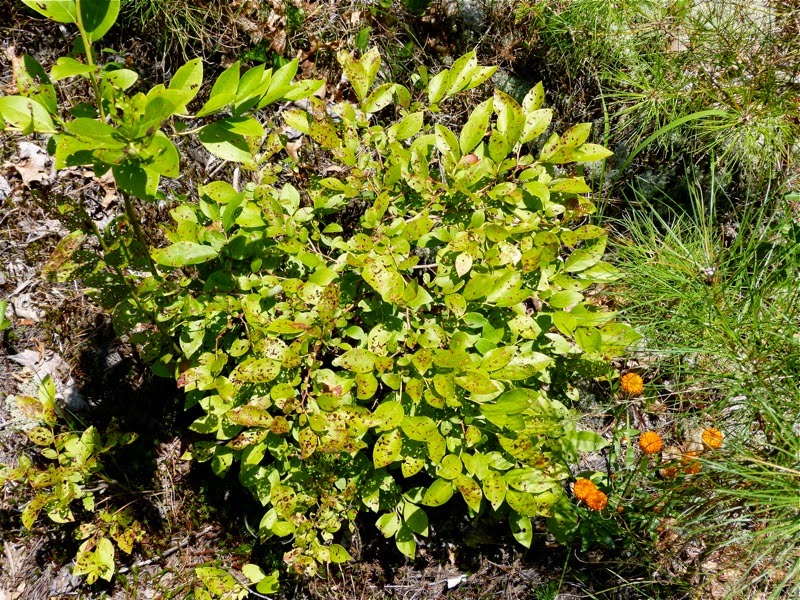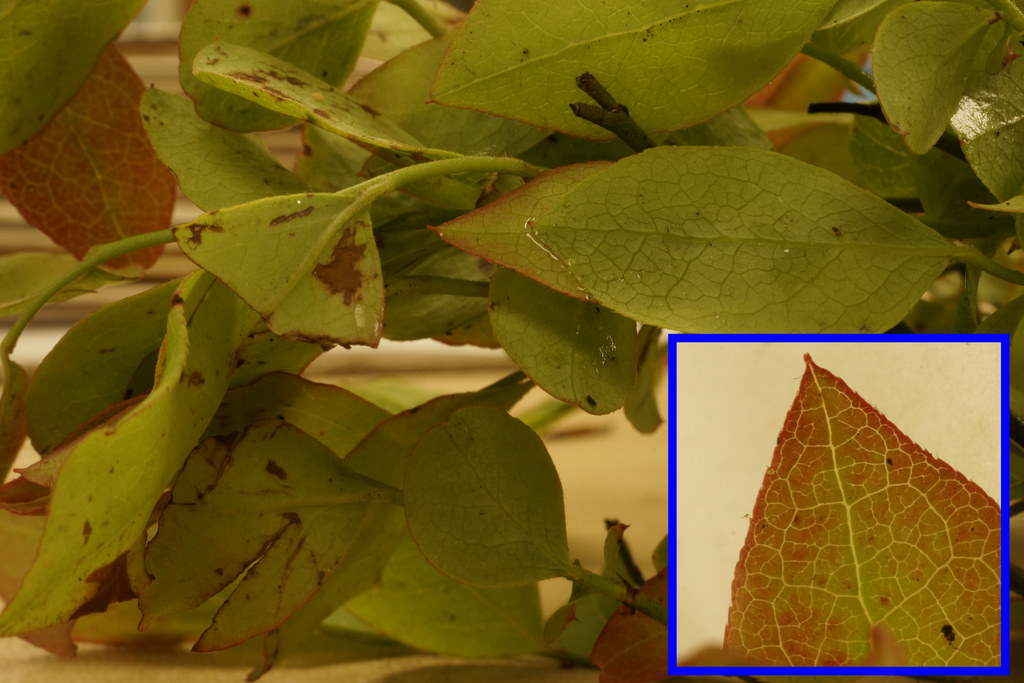Map Snapshot




















155 Records
Status
Found throughout Maryland. This is the only "low bush" blueberry on the Eastern Shore and the dominant "low bush" blueberry of the Fall Line and piedmont.
Description
Early Lowbush Blueberry can be differentiated from huckleberries by the lack of resinous dots on the leaves. Early Lowbush Blueberry can be separated from the similar Lowbush Blueberry (Vaccinium angustifolium) by looking at leaf coloration and structure. The leaves of Vaccinium angustifolium are bright and shiny on the undersides while the leaves of Vaccinium pallidum are dull green to whitish and not shiny. The leaf edge of Vaccinium angustifolium is more evenly serrated than the leaf edge of Vaccinium pallidum which can be entire or unevenly serrated. The leaves of Vaccinium pallidum are also typically wider and can be more rounded than the leaves of Vaccinium angustifolium.
Relationships
Host plant to various moth species including Dichomeris vacciniella, Fall Cankerworm Moth, Mottles Gray Carpet Moth, Sweetfern Geometer Moth, Begger Moth, Sulphur Moth, Canadian Melanolophia Moth, Large Lace-bordered Moth, Forest Tent Caterpillar Moth, Yellow-based Tussock Moth, Streaked Tussock Moth, Distinct Quaker Moth, Yellow-haired Dagger Moth, Triton Dagger Moth, Copper Underwing Moth, Graceful Underwing Moth, Formosa Looper Moth, American Dun-bar Moth, Alternate Woodling Moth, Sidus Sallow Moth, Intractable Quaker Moth, Ashen Pinion Moth, Bicolored Woodgrain Moth, Garman's Quaker Moth, Ruby Quaker Moth, Decorated Owlet Moth, Red-winged Sallow Moth, Slender Clearwing, Huckleberry Sphinx, Blueberry Leaftier Moth, Stain-backed Leafroller Moth, Fruit-tree Leafroller Moth, Oblique-banded Leafroller Moth, Serviceberry Leafroller Moth, Lacuna Moth, Raspberry Leafroller Moth, and Three-lined Leafroller Moth (Database of World's Lepidopteran Host Plants).
Seasonality Snapshot
Source: Wikipedia
| Vaccinium pallidum | |
|---|---|

| |
| Scientific classification | |
| Kingdom: | Plantae |
| Clade: | Tracheophytes |
| Clade: | Angiosperms |
| Clade: | Eudicots |
| Clade: | Asterids |
| Order: | Ericales |
| Family: | Ericaceae |
| Genus: | Vaccinium |
| Species: | V. pallidum
|
| Binomial name | |
| Vaccinium pallidum Aiton 1789
| |
| Synonyms[1] | |
|
Synonymy
| |
Vaccinium pallidum is a species of flowering plant in the heath family known by the common names hillside blueberry, Blue Ridge blueberry, late lowbush blueberry, and early lowbush blueberry. It is native to central Canada (Ontario) and the central and eastern United States (from Maine west to Wisconsin and south as far as Georgia and Louisiana) plus the Ozarks of Missouri, Arkansas, southeastern Kansas and eastern Oklahoma.[2]
Description
[edit]Vaccinium pallidum is a deciduous shrub, erect in stature but variable in height. It generally grows 23 to 51 centimeters (9 to 20 in) tall, but depending on environmental conditions it ranges from 8 centimeters (3.2 inches) to one full meter (40 inches) in height. It is colonial, sprouting from its rhizome to form colonies of clones. The shrub has greenish brown to red bark on its stems, and the smaller twigs may be green, reddish, yellowish, or gray. The alternately arranged leaves are also variable. They are generally roughly oval and measure 2 to 6 centimeters (0.8–2.4 inches) long. They are green to yellowish or bluish in color, turning red in the fall. The flowers are cylindrical, bell-shaped, or urn-shaped and are borne in racemes of up to 11. They are white to pinkish or greenish in color,[2] or "greenish white with pink striping",[1] and about half a centimeter[2] to one centimeter long.[1] They are pollinated by bees such as bumblebees and Andrena carlini.[1] The fruit is a berry up to 1.2 centimeters long. It is waxy blue to shiny black in color, or rarely pure white. It contains several seeds, a few of which are generally not viable. The plant reproduces sexually via seed and vegetatively by sprouting from the rhizome.[2][3] Cytology is 2n = 24, 48.[4][5]
Distribution and habitat
[edit]Vaccinium pallidum is native to central Canada (Ontario) and the central and eastern United States.[6] It grows in many types of habitat, including oak and chestnut woodlands, maple-dominated swamps, pine barrens, pine savanna, and a variety of forest types. It grows in the understory of trees such as red oak, black oak, white oak, post oak, chestnut oak, blackjack oak, Virginia pine, shortleaf pine, pitch pine, loblolly pine, longleaf pine, jack pine, eastern hemlock, red maple, and black cherry.[2]
Vaccinium pallidum is common on disturbed sites such as roadsides and abandoned fields. It also grows at climax in old-growth oak stands in the South Carolina piedmont. It can grow on dry, rocky soils, sandy and gravelly soils, and heavy clay. The climate is generally humid.[2]
Uses
[edit]The wild fruits are food for many types of bird and other animals. Each individual fruit has approximately eight calories. For humans the taste is "sweet to bland" and the fruit can be eaten fresh, in pies, or as jelly. The fruit is harvested and sold commercially in some areas, such as northeastern Alabama and northwestern Georgia. The plant is also grown as an ornamental.[2]
References
[edit]- ^ a b c d Vander Kloet, Sam P. (2009). "Vaccinium pallidum". In Flora of North America Editorial Committee (ed.). Flora of North America North of Mexico (FNA). Vol. 8. New York and Oxford: Oxford University Press – via eFloras.org, Missouri Botanical Garden, St. Louis, MO & Harvard University Herbaria, Cambridge, MA.
- ^ a b c d e f g Tirmenstein, D. A. (1991). "Vaccinium pallidum". Fire Effects Information System (FEIS). US Department of Agriculture (USDA), Forest Service (USFS), Rocky Mountain Research Station, Fire Sciences Laboratory.
- ^ "Vaccinium pallidum". County-level distribution map from the North American Plant Atlas (NAPA). Biota of North America Program (BONAP). 2014.
- ^ Redpath, Lauren E.; Aryal, Rishi; Lynch, Nathan; Spencer, Jessica A.; Hulse-Kemp, Amanda M.; Ballington, James R.; Green, Jaimie; Bassil, Nahla; Hummer, Kim; Ranney, Thomas; Ashrafi, Hamid (2022). "Nuclear DNA contents and ploidy levels of North American Vaccinium species and interspecific hybrids". Scientia Horticulturae. 297. Elsevier BV: 110955. doi:10.1016/j.scienta.2022.110955. ISSN 0304-4238.
- ^ Hall, Susan H.; Galletta, G. J. (1971). "Comparative Chromosome Morphology of Diploid Vaccinium Species1". Journal of the American Society for Horticultural Science. 96 (3). American Society for Horticultural Science: 289–292. doi:10.21273/jashs.96.3.289. ISSN 0003-1062.
- ^ "Vaccinium pallidum Aiton | Plants of the World Online | Kew Science". Plants of the World Online. Retrieved 2022-12-13.
External links
[edit] Media related to Vaccinium pallidum at Wikimedia Commons
Media related to Vaccinium pallidum at Wikimedia Commons Data related to Vaccinium pallidum at Wikispecies
Data related to Vaccinium pallidum at Wikispecies- United States Department of Agriculture Plants Profile
- The Nature Conservancy
- photo of herbarium specimen at Missouri Botanical Garden, collected in Missouri in 1991















